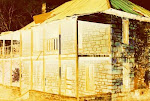Why exactly do we have to keep such exacting records of wind speed, temperature, registration numbers and amounts of product used? because this shit kills things. Dead dead dead.
I had to spray wildflowers yesterday.
I did not like it.
It was kinda sad to hose it down with 2,4-D. But, I had to.
Not only that I put out one of the triazines which are now on the target list of chems the EPA is concerned about. Why are they concerned? Water. They are getting into the water system. Time for some links. Brace yourself, this blog is likely to have some ponderous links. From the USGS report
Results showed that large amounts of triazine herbicides and their degradation products were flushed into streams with runoff. Much of this transport took place during the first runoff period after application of herbicides. Subsequent runoff tended to produce lesser concentration peaks. Herbicide detections in larger Midwestern streams tended to be seasonal with higher percentages in spring and early summer and lower percentages in fall and winter.The upshot being in the last couple of years, the EPA has decided that we should not apply this class of herbicides in the vicinity of water (let's make that 50 ft shall we? yes let's! oh and a bunch of other restrictions too!) and that includes things like ditches, creeks, ponds (natural or man-made) drains or other water moving thingamabobs.
I have a really strong feeling it is violated constantly. Scott's Bonus S contains atrazine, a triazine, it is heavily marketed in different areas than where this study was conducted, the Midwest (hey look Amarillo, you are now part of the Midwest!) farming areas. It works and is relatively inexpensive, but it moves around a bit too much and also has a rather long half-life, some variations lasting up to 230+ days in the soil. How many homeowners this weekend will apply this stuff right next to the creek that flows through their neighborhood? Time to get a label. Yes, I read the damn label. Regularly. The very first thing that jumps out at me is what turf you can use it on and where it is sold. This is stuff specifically for St. Augustine. You cannot use it on bermudagrass or bluegrass. But, wait there a second you told us this class of chems was used up in Amarillo and I know it is too damn cold there for St. Aug! Yep, you are right, so where is it coming from? This one. Atrazine 4L What crops does it mention regularly? Why that would be corn and sorghum. And where are those crops typically grown in the US of A? That would be the Midwest, including but not limited to Amarillo.
Now, let's get back to our homeowner friend. Did he or she read the label? Did they see the part on the Scott's one about not putting it out under trees or shrubs? Didja? Better check it again, the fine print, under restrictions and other shit you ought to know about. Not the big fancy advertising they paid good money for, no the teeny tiny writing the Feds make them put on there or some lawyer said they better because we have been having to pay off entirely too many people. They don't run that disclaimer on the ads I hear on my radio station or the ones that run on my TV. Nope, no mention of the water restrictions concerning this product or the damage it can cause to your great big Post Oaks. Y'know that one your wife liked so much that this house was the one she picked? Right, that one. No, he really doesn't say anything about that on the commercial does he? I guess they figured it wasn't a particularly good selling point. Now how they can sell this stuff at Home Depot without some mention of water(other than the standard boilerplate) is beyond me. If you have a wide expanse of St. Augustine lawn without any driplines of shrubs, trees or other ornamentals within the area, go for it. If you are like the thousands of homeowners with great big established trees don't say I didn't warn you.
There are no trees in the corn field. Those that might have been there a century ago were long since rooted up.
I suppose this is a plea to read the label of what you are using, whatever product it might be. Read it and understand it. Get past the fancy adverts and read the important stuff at the bottom.



1 comment:
At least you work within the safety net, as you say anyone going into the garden centre/DIY place and picking up stuff to spray will probably not give it a thought. At the end of the day, we all eat, breathe and drink stuff every day that doesn't do us much good. But that I think is the price we have to pay for the benefits that modern science/technology brings.
Post a Comment